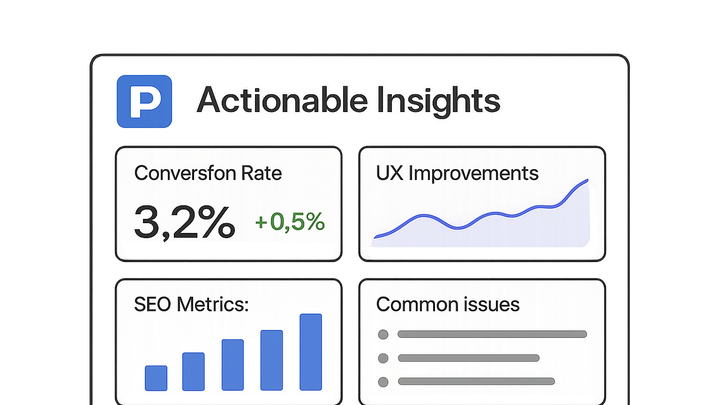Published on 2025-06-29T19:55:53Z
What are Actionable Insights? Examples in CRO/UX/SEO
Actionable insights are clear, data-driven recommendations that guide specific improvements to a website’s performance, user experience (UX), and search engine optimization (SEO). Unlike raw data or generic metrics, actionable insights offer precise directions on what to change, why it matters, and how it will impact key performance indicators (KPIs) such as conversion rate, bounce rate, and organic traffic. In the context of CRO/UX/SEO, these insights often stem from a combination of quantitative metrics (e.g., A/B tests, heatmaps, page speed scores) and qualitative feedback (e.g., user interviews, usability tests). Tools like Prevue.me can automatically generate critiques across CRO, lead generation, SEO, UX, and accessibility, surfacing high-priority findings to maximize lead capture and improve overall site effectiveness. By focusing on insights that are relevant, specific, and feasible, teams can prioritize and implement changes that drive measurable business outcomes.
Actionable insights
Clear, data-driven recommendations that guide specific CRO, UX, and SEO improvements to boost conversions and traffic.
Understanding Actionable Insights
Actionable insights are not just data points; they are practical recommendations derived from analyzing metrics and user feedback. These insights help teams make targeted improvements that align with business objectives and improve key website metrics. In CRO/UX/SEO, actionable insights bridge the gap between raw data and real-world optimizations, ensuring that every change is purposeful and measurable.
-
Relevance
Insights must be closely tied to specific business goals or user needs to ensure they drive meaningful impact.
- Goal alignment:
Link each insight to metrics like conversion rate, average session duration, or keyword rankings.
- Goal alignment:
-
Clarity
Recommendations should be straightforward and unambiguous, so teams know exactly what action to take.
- Specificity:
Use concrete language (e.g., “Reduce form fields from 5 to 3” vs. “Simplify the form”).
- Specificity:
-
Feasibility
Ensure actions can be implemented within technical, budgetary, and time constraints.
- Prioritization:
Assess the effort vs. impact to focus on high-value changes first.
- Prioritization:
Sources of Actionable Insights
Gathering insights requires a mix of quantitative and qualitative data. Each source offers unique perspectives on user behavior, technical performance, and search visibility. Combining multiple sources ensures a holistic view and more robust recommendations.
-
Quantitative data
Numeric metrics collected through analytics platforms provide measurable evidence of user behavior and site performance.
- Google analytics:
Traffic patterns, goal completions, and user flow.
- Heatmaps:
Visualize where users click, scroll, and hover.
- A/b testing:
Compare variations to identify what drives higher conversion rates.
- Google analytics:
-
Qualitative feedback
User opinions and observations reveal motivations, frustrations, and expectations.
- User interviews:
In-depth conversations to uncover user needs.
- Surveys:
Structured questions for broader audience feedback.
- Usability testing:
Observe real users completing tasks to find pain points.
- User interviews:
-
Automated audits with prevue.me
Leverage AI-driven critiques to identify high-priority issues in CRO, UX, SEO, and accessibility.
- Lead generation optimization:
Recommendations to maximize form completions and newsletter signups.
- Seo recommendations:
Suggest improvements in metadata, keyword usage, and page structure.
- Accessibility checks:
Highlight WCAG violations for remediation.
- Lead generation optimization:
Turning Data into Actionable Insights
Transforming raw data into actionable insights involves a structured process. This ensures that observations lead to prioritized, implementable actions.
-
Data collection
Aggregate relevant metrics and feedback from chosen sources.
- Define metrics:
Select KPIs aligned with business goals (e.g., conversion rate, bounce rate).
- Define metrics:
-
Analysis & pattern detection
Use statistical methods and user journey mapping to spot trends and bottlenecks.
- Segmentation:
Break down data by device type, traffic source, or demographics.
- Segmentation:
-
Insight formulation
Convert patterns into clear recommendations with expected outcomes.
- Hypothesis statement:
Frame insights as testable hypotheses (e.g., “Reducing image size will cut load time by 20%”).
- Hypothesis statement:
-
Prioritization & action planning
Rank insights by impact and feasibility, then assign tasks to relevant stakeholders.
- Effort-impact matrix:
Visual tool to prioritize quick wins and high-impact projects.
- Effort-impact matrix:
Examples of Actionable Insights
Real-world examples show how specific recommendations drive improvements in CRO, UX, and SEO.
-
Optimize page load speed
Insight: Pages taking longer than 3 seconds see 50% higher bounce rates.
- Compress images:
Use modern formats (WebP) and lazy loading to speed up.
- Minify js/css:
Reduce file sizes by removing unnecessary code.
- Compress images:
-
Simplify navigation menu
Insight: Users struggle to find key pages, leading to drop-offs.
- Consolidate links:
Group related pages under clear labels.
- Add search bar:
Enable direct access to content.
- Consolidate links:
-
Improve meta descriptions
Insight: Low click-through rates from SERPs indicate unappealing snippets.
- Add target keywords:
Incorporate primary keyword within 155 characters.
- Include call-to-action:
Use action words like “Discover,” “Learn,” or “Save.”
- Add target keywords:
Best Practices and Common Pitfalls
Implementing actionable insights effectively requires discipline and strategic focus.
-
Focus on high-impact changes
Prioritize insights that align with core objectives and promise significant ROI.
-
Avoid analysis paralysis
Set time limits for analysis phases to maintain momentum.
-
Measure before & after
Use A/B tests or control groups to validate the effectiveness of changes.
-
Iterate continuously
Treat insights as living recommendations and refine them with ongoing data.
